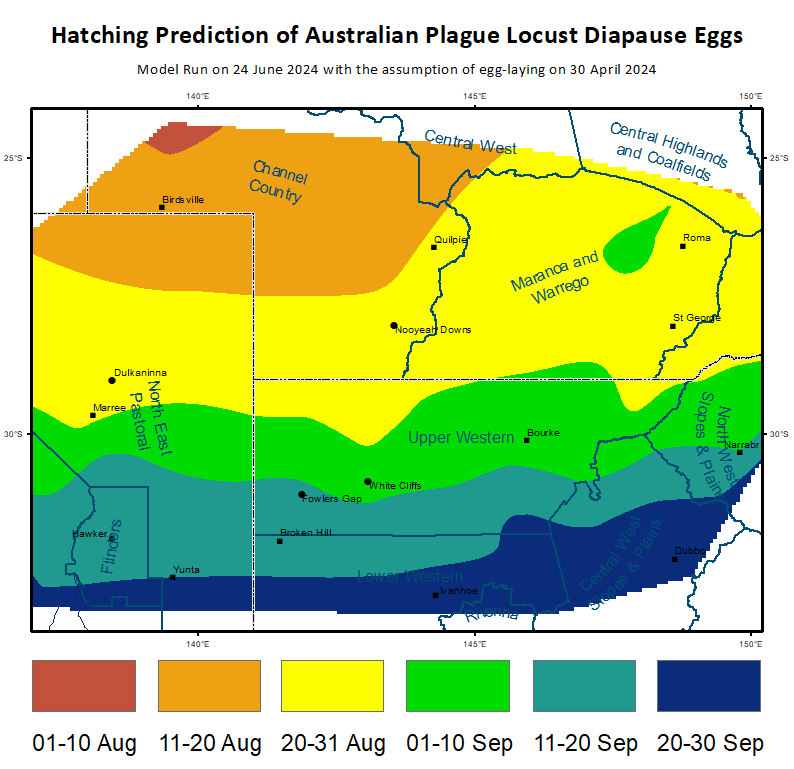Destruction in numbers: locusts on the increase
Kristin Murdock
30 June 2024, 9:20 PM
 Locust bands and swarms are developing in a number of areas of the western plains.
Locust bands and swarms are developing in a number of areas of the western plains.In plague proportions, locusts can spell disaster for farmers.
The latest count from the Australian Plague Locust Commission (APLC) shows a moderate increase in numbers including sites in our Western Plains area.
Locust plagues are nothing new, they were even recounted in the Bible!
In Australia, damaging locust outbreaks were first reported back in the 1870s, affecting inland agricultural areas of New South Wales, South Australia and Victoria.
Since then, a pattern of high density populations develop in some locations in most years, with less frequent very large 'plague' populations extending across several states for one or two years.
The most recent APLC reports say local locust populations have increased moderately across inland eastern Australia in autumn, with bands and swarms developing in the Lightning Ridge, Narrabri, Walgett and Nyngan areas, as well as in parts of South Australia.
The warning was sounded earlier this year when in April, Local Land Services was urging farmers to remain vigilant and lookout for signs of plague locusts.
NSW Locust Commissioner Andrew Mulligan said early reporting of suspected locust activity was the best way to help protect agriculture against the threat and urged farmers to remain vigilant.
“Land managers need to report plant pest locust activity to their Local Land Services biosecurity officer within one working day after they first suspect or become aware of it and undertake control measures if appropriate," Mr Mulligan said.
“This will help to limit potential impacts of plague locusts, which can devastate crops and pasture."
Egg laying swarm of Australian plague locusts Photo courtesy R. Eade, NSW LHPA
Not all locusts are the same, but they all seem to like our Western Plains conditions. In Australia there are three main pest species of locust: Australian plague locust, spur-throated locust and the migratory locust - all of which are native.
Latest reports state all three of these species have been noticed with increased populations in our area, particularly in the north-west.
For a little creature, they can cause a lot of damage, but only when in huge numbers.
Baby plague locusts (nymphs) are estimated to consume 0.04 gm of green vegetation per day, averaged across all development stages.
Locust nymphs (3-4 mm long) emerging from soil. The white 'caps' are the remains of the egg yolk sac. IMAGE: DAFF
Average adult food intake has been estimated to be about 0.2 grams of green vegetation per day.
With densities of adults in settled swarms ranging from about 4 to 50/m2, a swarm covering an area of 1km2 could consume over 1000 kg of green vegetation a day, depending on density.
Adult Australian plague locusts are nomadic and swarms can move twenty kilometres in a day. They also make long distance nocturnal migratory flights at heights up to 1000 metres.
They can be transported over long distances by upper-level winds. Adults of the Australian plague locust and spur-throated locust species are capable of migrating over very large distances.
Overnight migrations up to several hundred kilometres are not uncommon and this behaviour can lead to the sudden appearance of large numbers of locusts in previously uninfested areas.

The locust outlook for spring is for overall low-medium level populations across inland eastern Australia, with localised high-density populations developing from overwintering eggs in the Central West of NSW.
Localised bands may develop from early September onwards in our Central West region, but could be from early August onwards in the North East of SA and Channel Country of Queensland.
There is a moderate-high probability of some significant localised populations developing from late winter onwards in several areas and a high likelihood of regional infestations developing in spring.
And for the really big question - what is the difference between a locust and a grasshopper? Believe it or not, it's mainly based on their social habits!
Locusts and grasshoppers are the same in appearance, but locusts can exist in two different behavioural states (solitary and gregarious), whereas most grasshoppers do not.
When the population density is low, locusts behave as individuals, much like grasshoppers.
However, when locust population density is high, individuals undergo physiological and behavioural changes, known as phase polyphenism, and they form gregariously behaving bands of nymphs or swarms of adults. Hence locust plagues and not grasshopper plagues!
Anyone suspecting locust activity on their land should contact their Local Land Services Biosecurity Officer on 1300 795 299 or contact the Department of Agriculture through this link



